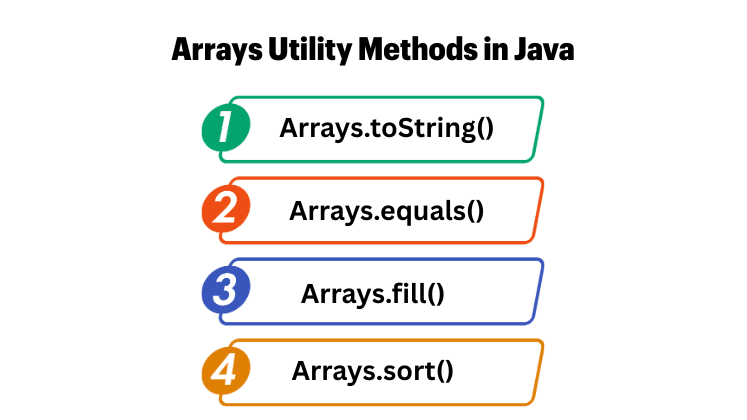Arrays Utility Methods in Java
When working with arrays, Java provides a powerful helper class — java.util.Arrays.
This class contains static utility methods that make it easier to perform common array operations like:
- Converting arrays to readable strings
- Comparing arrays
- Filling arrays with default values
- Sorting arrays efficiently
Using these methods helps write cleaner, faster, and more readable code.

1. Arrays.toString() – Convert Array to Readable String
Normally, printing an array directly like this:
int[] numbers = {1, 2, 3, 4, 5};
System.out.println(numbers);
prints something like:
[I@15db9742
That’s the array’s memory reference, not its content.
To print the actual elements, use Arrays.toString():
import java.util.Arrays;
public class ToStringExample {
public static void main(String[] args) {
int[] numbers = {1, 2, 3, 4, 5};
System.out.println("Array: " + Arrays.toString(numbers));
}
}
Output:
Array: [1, 2, 3, 4, 5]
Notes:
- Converts array elements into a single string format.
- Works for all primitive and object arrays.
- For multidimensional arrays, use
Arrays.deepToString()instead.
Example (Multidimensional):
int[][] matrix = {{1, 2}, {3, 4}};
System.out.println(Arrays.deepToString(matrix));
Output:
[[1, 2], [3, 4]]
2. Arrays.equals() – Compare Two Arrays
The equals() method checks whether two arrays contain the same elements in the same order.
import java.util.Arrays;
public class EqualsExample {
public static void main(String[] args) {
int[] arr1 = {10, 20, 30};
int[] arr2 = {10, 20, 30};
int[] arr3 = {30, 20, 10};
System.out.println(Arrays.equals(arr1, arr2)); // true
System.out.println(Arrays.equals(arr1, arr3)); // false
}
}
Output:
true
false
Notes:
- Returns
trueonly if both arrays have equal length and elements. - For multidimensional arrays, use
Arrays.deepEquals().
Example (Nested Arrays):
String[][] names1 = {{"Aman", "Ravi"}, {"Neha", "Tina"}};
String[][] names2 = {{"Aman", "Ravi"}, {"Neha", "Tina"}};
System.out.println(Arrays.deepEquals(names1, names2)); // true
3. Arrays.fill() – Fill Array with a Specific Value
Used to initialize or reset all elements of an array with a single value.
import java.util.Arrays;
public class FillExample {
public static void main(String[] args) {
int[] marks = new int[5];
Arrays.fill(marks, 100);
System.out.println("Filled Array: " + Arrays.toString(marks));
}
}
Output:
Filled Array: [100, 100, 100, 100, 100]
Notes:
- Great for default initialization.
- Can also fill a range using
Arrays.fill(array, fromIndex, toIndex, value)
Example (Range Fill):
int[] scores = {10, 20, 30, 40, 50};
Arrays.fill(scores, 1, 4, 99);
System.out.println(Arrays.toString(scores));
Output:
[10, 99, 99, 99, 50]
4. Arrays.sort() – Sort Array in Ascending Order
The Arrays.sort() method is used to sort elements of an array in ascending order by default.
import java.util.Arrays;
public class SortExample {
public static void main(String[] args) {
int[] numbers = {5, 2, 8, 1, 3};
Arrays.sort(numbers);
System.out.println("Sorted Array: " + Arrays.toString(numbers));
}
}
Output:
Sorted Array: [1, 2, 3, 5, 8]
Notes:
- Works for primitive arrays and object arrays.
- For descending order: use
Collections.reverseOrder()(works forInteger[], notint[]).
Descending Example:
import java.util.*;
public class DescendingExample {
public static void main(String[] args) {
Integer[] numbers = {5, 2, 8, 1, 3};
Arrays.sort(numbers, Collections.reverseOrder());
System.out.println("Descending Order: " + Arrays.toString(numbers));
}
}
Points to Remember
- Always use
deepToString()anddeepEquals()for nested arrays. Arrays.fill()is useful for default initialization.Arrays.sort()is optimized and very fast for large arrays.- All these methods are static, so you can call them directly using the class name.
🏆 Top 5 Interview Questions – Arrays Utility Methods in Java
1. What is the difference between Arrays.equals() and Arrays.deepEquals()?
Answer:
Arrays.equals()→ Compares one-dimensional arrays only.Arrays.deepEquals()→ Compares nested or multidimensional arrays.
Example:
int[][] arr1 = {{1,2}, {3,4}};
int[][] arr2 = {{1,2}, {3,4}};
System.out.println(Arrays.equals(arr1, arr2)); // false
System.out.println(Arrays.deepEquals(arr1, arr2)); // true
2. How do you print arrays in Java?
Answer:
- Use
Arrays.toString(array)for 1D arrays. - Use
Arrays.deepToString(array)for multidimensional arrays.
Example:
int[][] matrix = {{1,2}, {3,4}};
System.out.println(Arrays.deepToString(matrix));
Output:
[[1, 2], [3, 4]]
3. Can you fill only part of an array using Arrays.fill()?
Answer: Yes, using the range version:
int[] arr = {10, 20, 30, 40, 50};
Arrays.fill(arr, 1, 4, 99);
System.out.println(Arrays.toString(arr));
Output:
[10, 99, 99, 99, 50]
4. How do you sort an array in descending order?
Answer:
- Use
Arrays.sort()withCollections.reverseOrder()for object arrays likeInteger[]. - Primitive arrays (
int[]) must be converted toInteger[]first.
Example:
Integer[] numbers = {5, 2, 8, 1, 3};
Arrays.sort(numbers, Collections.reverseOrder());
System.out.println(Arrays.toString(numbers));
Output:
[8, 5, 3, 2, 1]
5. What are some important points about Arrays utility methods?
Answer:
- Methods are static, no need to create an instance.
deepToString()anddeepEquals()are used for nested arrays.Arrays.sort()is optimized and fast, works for primitive & object arrays.Arrays.fill()helps in initializing arrays quickly.- Always remember the difference between primitive arrays and object arrays when using methods like
sort()orreverseOrder().

